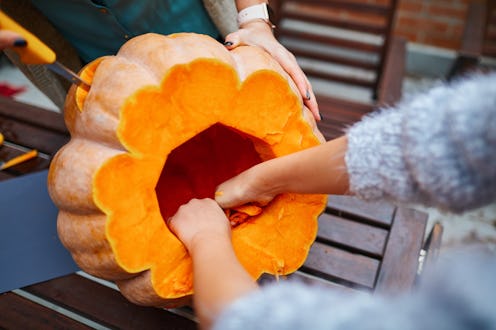
Halloween is a holiday filled with fun traditions, from trick or treating to dressing up to bobbing for apples. One of my favorite Halloween holiday traditions is carving pumpkins, though this leads me to wonder: Why do we carve pumpkins for Halloween, anyway? Sure, pumpkins are a fruit we generally associate with autumn, but why do we actually carve them? And why so often with a person's face?
I'll admit it: I think there's something a little extra creepy behind the jagged teeth, narrow eyes, and noseless face we tend to see on people's porches in late October. I'll also be the first to confess that when pumpkin carving rolls around, I tend to leave the knife-wielding and pumpkin-guts-pulling to someone else, then come in to cover my pumpkin with paint and glitter at the end.
As history would have it, though, there is a pretty thorough explanation as to why we carve pumpkins for Halloween. It's true that, as is the case whenever you trace back the origins of cultural norms and societal trends, people have different ways of celebrating Halloween all over the world, and pumpkin carving is no exception; interestingly, though, the general lore behind the activity always stems from the same place.
As explained over at History.com, pumpkin carving goes back to an Irish myth from centuries ago. According to the story, a man named "Stingy Jack" invited the Devil to have a drink with him — and, as his name may suggest, Stingy Jack didn't want to pay his own tab. Stingy Jack may have been cheap, but he was also clever; he managed to convinced the Devil to turn himself into a coin, which he then used to settle the bill. Quick thinking, right?
This was not the end of the Devil and Stingy Jack, however. In fact, their story goes on for another 10 years: First, under the condition that the Devil would not take Stingy Jack's soul, Stingy Jack released him from the coin (what a nice guy, right?); however, according to the legend, he also tricked him just a short year later by getting him stuck in a tree. (Stingy Jack, it seems, was never quite Nice Jack.)
Then, lo and behold, Stingy Jack died. As Jason DeRusha explains for CBS, legend has it that God wasn't about to let Stingy Jack into Heaven, given his horrible behavior — but the Devil didn't want to let Stingy Jack enter his domain, either. (Understandable, given Stingy Jack's treatment of him over the years.)
So, what's a fellow to do for all eternity? The Devil doomed Stingy Jack to walk the Earth at night with a piece of coal to light his way. Ever resourceful, Stingy Jack put his coal in a carved-out turnip and went on his way. As Heather Whipp explains at LiveScience, legend has it that this is when Irish culture began referring to "Jack of the Lantern" and then simply "Jack O'Lanterns."
Over time, of course, the way we practice this tradition has shifted. In Ireland and Scotland, Jack-O-Lanterns picked up earliest, with people carving faces into turnips and potatoes to ward off Stingy Jack and other spirits roaming the Earth on Halloween. As the tradition spread, different cultures began using different foods, depending on what was available to them. For example, in England, it was common for people to make Jack-O-Lanterns out of beets — and, as explained over at HowStuffWorks, Irish immigrants arriving in America later on realized that pumpkins, which are native to the United States and grow abundantly around Halloween, were the perfect fruit for Jack-O-Lanterns.
And that, everybody, is why we carve Jack-O-Laterns out of pumpkins on Halloween. Have a safe and happy holiday!
Images: vgajic/E+/Getty Images; Giphy (2)